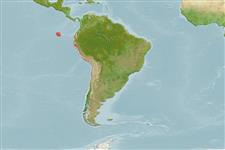Issue
Family placement uncertain; see also the genus account: incertae sedis in Percoidei, Johnson, 1984.
Environment: milieu / climate zone / depth range / distribution range
Ökologie
seewasser; tiefenbereich 10 - 55 m (Ref. 104864). Tropical; 2°N - 54°S, 92°W - 70°W
Southeast Pacific: Peru to Chile and the Galapagos Islands.
Size / Gewicht / Alter
Maturity: Lm ? range ? - ? cm
Max length : 50.0 cm SL Männchen/unbestimmt; (Ref. 28023); max. veröff. Gewicht: 1.7 kg (Ref. 53696)
Rückenflossenstacheln (insgesamt): 10; Rückenflossenweichstrahlen (insgesamt): 10-11; Afterflossenstacheln 3. Deep, compressed body, brown, somewhat lighter on the lower half; a dark streak along the lateral line. Large mouth, compressed head. Serrated preopercular margin. Lateral line complete. Small scales. Caudal fin emarginate (Ref. 28023).
Found near drop-offs and among rock out-croppings over sand and rock, in depths greater than 10 meters. Feeds on small fishes and crustaceans (Ref. 28023).
Life cycle and mating behavior
Geschlechtsreife | Fortpflanzung | Ablaichen | Eier | Fecundity | Larven
Grove, J.S. and R.J. Lavenberg, 1997. The fishes of the Galápagos Islands. Stanford University Press, Stanford, 863 p. (Ref. 28023)
IUCN Rote Liste Status (Ref. 130435)
Bedrohung für Menschen
Harmless
Nutzung durch Menschen
Fischereien: kleinfischerei
Mehr Information
NamenSynonymeMetabolismusRäuberÖkotoxikologieFortpflanzungGeschlechtsreifeAblaichenSpawning aggregationFecundityEierEientwicklung
ReferenzenAquakulturAquakultur ProfilZuchtlinienGenetikElectrophoresesVererbbarkeitKrankheitenVerarbeitungNutrientsMass conversion
PartnerBilderStamps, Coins Misc.LauteCiguateraGeschwindigkeitSchwimmstilKiemenoberflächeOtolithsGehirngrößeSehfähigkeit
Tools
Zusatzinformationen
Download XML
Internet Quellen
Estimates based on models
Preferred temperature (Ref.
123201): 16.5 - 23.1, mean 20.1 °C (based on 24 cells).
Phylogenetic diversity index (Ref.
82804): PD
50 = 1.0000 [Uniqueness, from 0.5 = low to 2.0 = high].
Bayesian length-weight: a=0.01230 (0.00579 - 0.02614), b=3.00 (2.81 - 3.19), in cm total length, based on LWR estimates for this species & (Sub)family-body (Ref.
93245).
Trophic level (Ref.
69278): 4.3 ±0.6 se; based on diet studies.
Fishing Vulnerability (Ref.
59153): Moderate vulnerability (44 of 100).
Nutrients (Ref.
124155): Calcium = 92.6 [48.5, 191.1] mg/100g; Iron = 1.16 [0.58, 2.10] mg/100g; Protein = 18.1 [16.1, 19.8] %; Omega3 = 0.255 [0.149, 0.447] g/100g; Selenium = 37.4 [19.4, 79.9] μg/100g; VitaminA = 48.9 [15.7, 164.2] μg/100g; Zinc = 1 [1, 1] mg/100g (wet weight);
